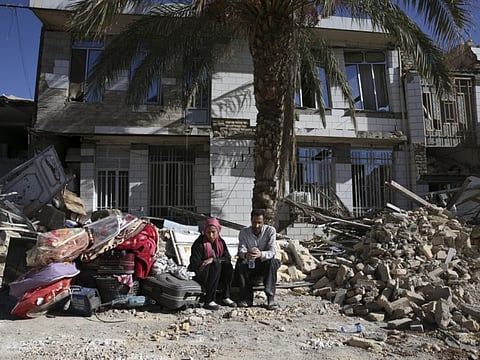30,000 homes damaged, destroyed by Iran quake
Survivors scramble to seek shelter from the bitter cold two days after devastating quake kills over 400

Kermanshah, Iran: Thousands of homeless Iranians sought shelter from bitter cold on Tuesday as the country marked a day of mourning for the over 400 killed in the 7.3-magnitude quake that struck a mountainous region spanning the Iran-Iraq border late Sunday.
Thousands of homes were destroyed in the quake, which rocked a region spanning Iran’s western province of Kermanshah and neighbouring Iraqi Kurdistan.
On Tuesday, residents who had fled their homes awoke from a second night in the cold outdoors as authorities struggled to get aid into the quake zone.
Iranian President Hasan Rouhani visited the city of Kermanshah and promised the government would move swiftly to help those left homeless by the disaster.
Around 12,000 Iranian homes were destroyed and another 15,000 damaged in the quake, according to official estimates.
Seven towns and nearly 2,000 villages were damaged, authorities said, and several villages were completely wiped from the map.
The toll in Iran stood at 430 dead and 7,460 injured, while across the border in more sparsely populated areas of Iraq, the health ministry said eight people had died and several hundred were injured. Iraq’s Red Crescent put the toll at nine dead.
On Tuesday, Iran marked a day of mourning, with a black banner adorning the corner of images of the disaster broadcast by state television to the tune of “Sad Lisa” by British singer Yousuf Islam, formerly known as Cat Stevens.
The headline of a state newspaper read “Iran cries with Kermanshah”, referring to the Kurdish-majority province.
“Search operations are reaching their end, with teams constantly monitoring the situation to know if there are still people to extract from the rubble,” Behnam Saidi, the spokesman for a crisis unit set up to handle the response to the quake, told state television.
But more aid was still needed.
“The most urgent need is to provide solutions for heating, housing and food,” Pir Hossein Koolivand, the head of national rescue services, told state television.
“Today, we sent our ambulances to villages in areas affected by the quake to help people rescued yesterday, including changing their bandages,” he said.
He added that “psychological support teams” had been sent to these areas.
The authorities said water and electricity had returned to most affected regions.
Rouhani on Tuesday visited the town of Sar-e Pol-e Zahab, worst hit by the quake.
At least 280 people were killed in the town, home to some 85,000 people, where crumpled vehicles lay under the rubble of flattened buildings on the streets.
On Monday, Iranian officials said they were setting up relief camps for the displaced and that 22,000 tents, 52,000 blankets and tonnes of food and water had been distributed.
The official IRNA news agency said 30 Red Crescent teams had been sent to the area.
Hundreds of ambulances and dozens of army helicopters were reported to have joined the rescue effort after supreme leader Ayatollah Ali Khamenei ordered the government and armed forces to mobilise “all their means”.
By late Monday, officials said all the roads in Kermanshah province had been reopened.
Sunday’s quake struck along a 1,500-kilometre (950-mile) fault line between the Arabian and Eurasian tectonic plates, which extends through western Iran and northeastern Iraq.
The area sees frequent seismic activity.
In 1990, a 7.4-magnitude quake in northern Iran killed 40,000 people, injured 300,000 and left half a million homeless, reducing dozens of towns and nearly 2,000 villages to rubble.
Thirteen years later, a catastrophic quake flattened swathes of the ancient southeastern Iranian city of Bam, killing at least 31,000.
Iran has experienced at least two major quake disasters since - one in 2005 that killed more than 600 people and another in 2012 that left some 300 dead.
Sign up for the Daily Briefing
Get the latest news and updates straight to your inbox



